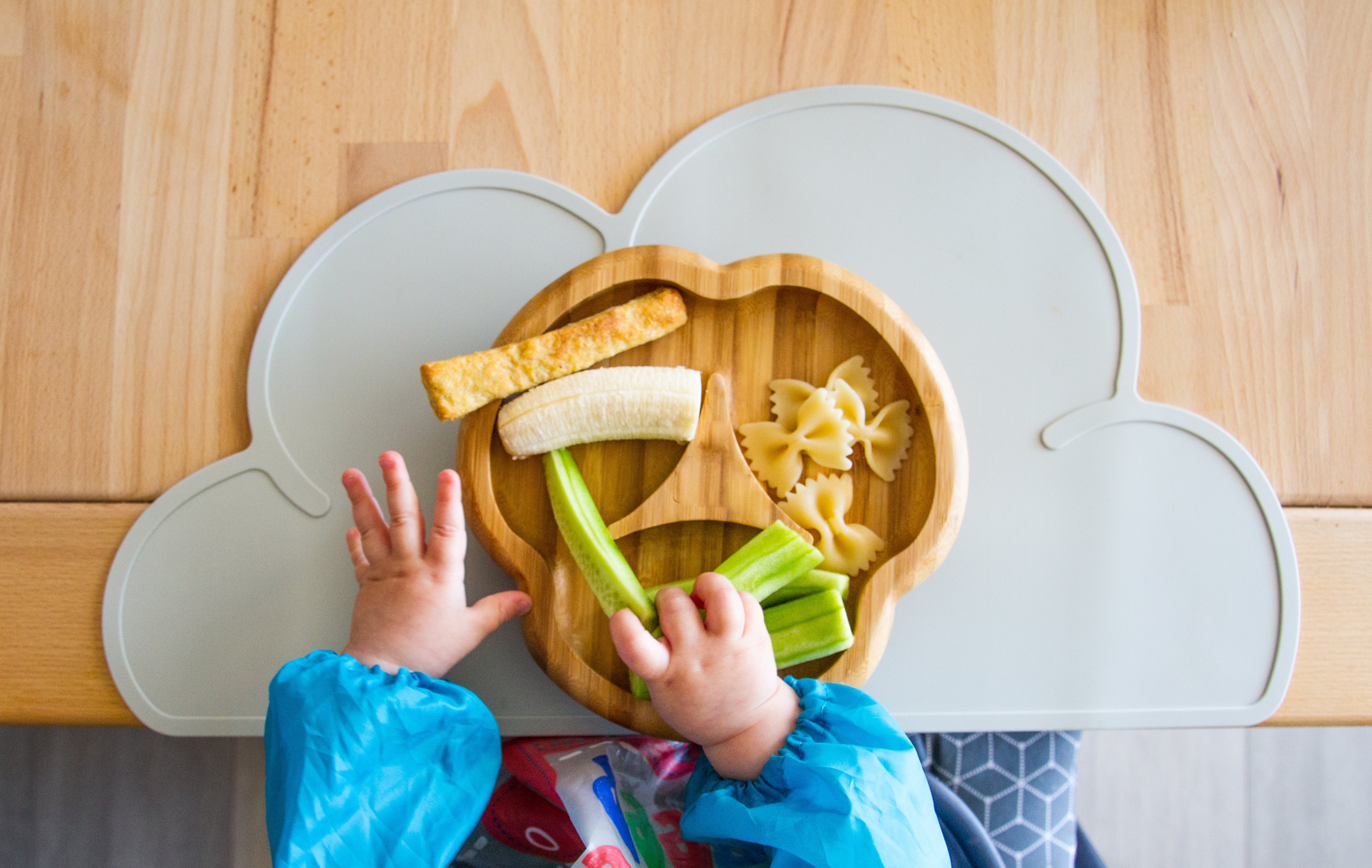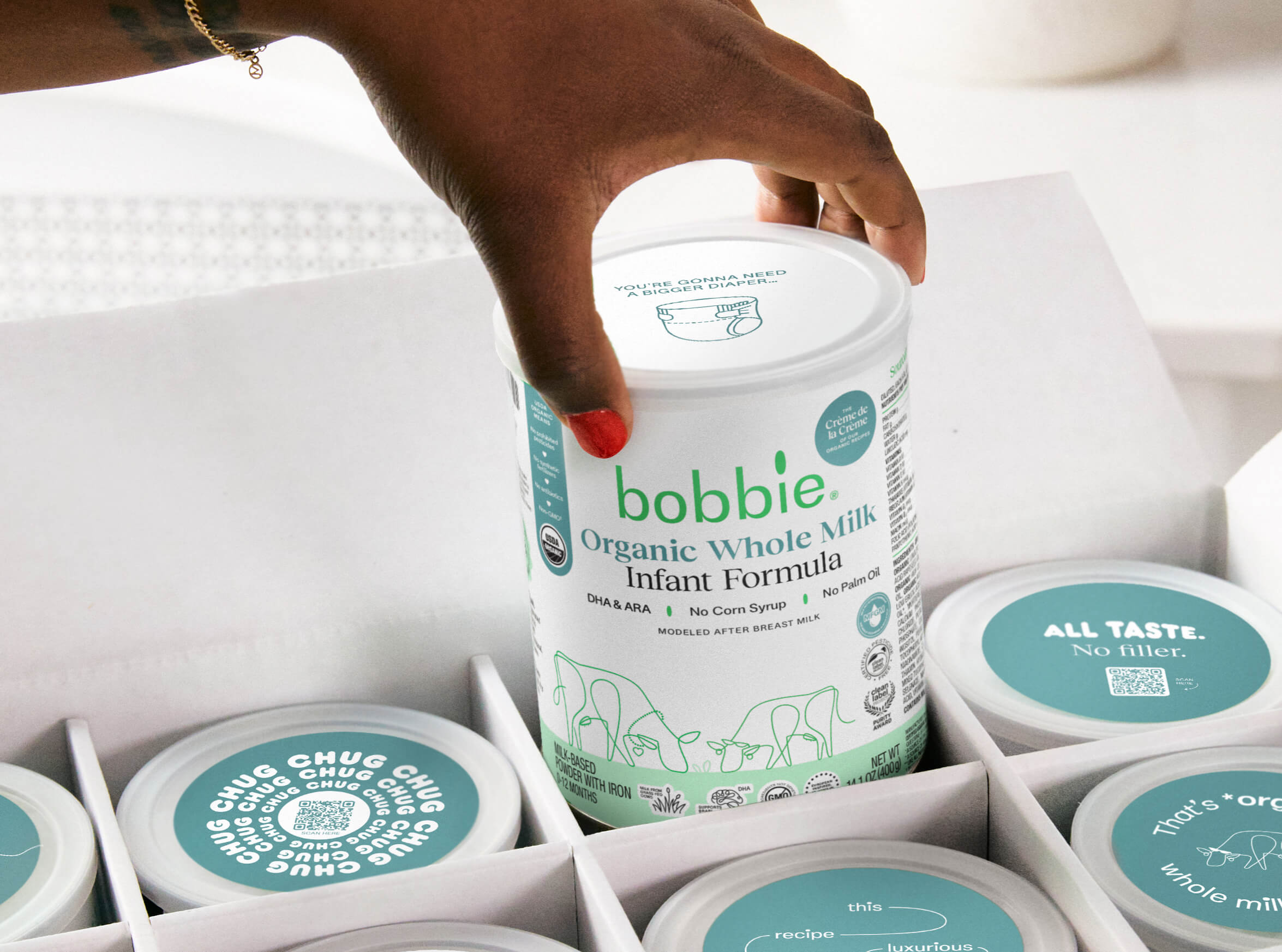Published September 24, 2024

When Do Babies Transition to Solid Foods & Stop Drinking Formula?
Your baby's transition from infant formula to solid foods and other drinks is a big step in their growth journey. But how do you know when it’s time to gradually make the transition? Whether you're just curious or gearing up for this milestone, we've got you covered with all the info you need to confidently navigate this next chapter.
Read on to explore key signs that your little one is ready to say goodbye to formula feeding and hello to even more new tastes and textures. Plus, we'll share some handy tips to make the switch as smooth as possible.
General Age Guidelines for Transitioning to Solid Foods
The formula-feeding journey is a crucial chapter in your baby’s early life, packed with the essential nutrients that fuel their growth and development. There are a few different ways to support your baby's nutritional needs before it’s time to switch entirely to solids, including:
- Breast milk: Breast milk is the gold standard in infant nutrition, offering the perfect blend of nutrients, antibodies and enzymes that support immunity and digestion; not to mention bonding between you and your little one. According to the U.S. Breastfeeding Committee, 83.2% of infants start with breastfeeding.
- Cow’s milk-based infant formula: Cow's milk infant formula is the most common breast milk alternative, modeled after its balanced mix of proteins, fats and carbs. Formulas are fortified with vitamins and minerals like iron to prevent deficiencies.
- Specialized prepared infant formula: Designed for babies with specific health needs, such as premature infants or those with certain metabolic disorders, specialized formulas offer tailored nutrition.
- Soy-based infant formula: A soy formula provides similar nutrients to cow’s milk-based formulas, but because they're made from soy milk protein, they're an ideal option for babies with lactose intolerance or those whose parents prefer a plant-based lifestyle.
Bobbie infant formulas are clean, EU-style infant formulas that meets all FDA requirements. They are complete nutrition, milk-based powder, modeled after breast milk and is easy on tummies. They are all non-GMO and do not have corn syrup, palm oil, or maltodextrin. Shop Bobbie today!
Shop Bobbie Baby Formula

Timing the Transition to Solids
After mastering the infant feeding journey, you might be wondering when to start introducing solid foods. The American Academy of Pediatrics recommends introducing foods other than breast milk or infant formula around 6 months of age. This is when your little one may show signs that they’re ready to explore new tastes and textures. This doesn’t mean they’ll stop bottle feeding or drinking formula immediately — solid foods should complement their formula or breast milk intake during the remainder of the first year. As they get more comfortable with solids, you’ll gradually reduce the formula. The Cleveland Clinic reports that by the time they’re around 12 months old, most babies can fully transition from formula to a balanced diet of solid foods and other drinks, like water and whole milk.
Introducing a range of solid foods ensures they get the necessary vitamins, minerals, and other nutrients they need, and promotes appropriate oral-motor development and fine motor skills. Following these general age guidelines can help you confidently guide your baby through this exciting milestone.
4 Signs Your Baby Is Ready for Solid Foods
Understanding the typical age-based recommendations for weaning your baby off breast milk or formula feeding is important, but there are other signs that can indicate they’re ready for new tastes and textures. Here are some common cues that your little one might be ready to start solid foods:
1. An Increased Interest in Food
If your baby is eyeing your plate, reaching for your food, or even mimicking your eating motions, they’re likely curious and ready to explore new foods. This fascination with your meals is a good indicator they’re prepared for solids.
2. Ability To Sit Up Without Support
When your little one can sit up on their own without wobbling, it’s a strong sign they’re ready to handle solid foods. This stability is important for safely eating and digesting different textures.
3. Good Coordination
Watch for signs that your baby is developing hand-to-mouth coordination, such as reaching for objects and bringing them to their mouth. Improved coordination helps them manage solid foods more effectively.
4. Diminished Tongue-Thrust Reflex
When your baby’s tongue-thrust reflex starts to fade, they can move food around in their mouth and swallow more easily. This development makes it easier to introduce various tastes and textures into their diet.
If you're unsure whether these signs are present or if it's the right time to incorporate solid foods, your pediatrician is always the best resource. They can offer professional guidance tailored to your baby’s specific health and developmental needs.
Tips for a Smooth Transition and Overcoming Challenges
Once your baby reaches 6 months or shows signs that they’re ready for solids, use these tips and tricks for a successful transition to food in addition to breast milk or prepared formula:
- Start slow and simple: Begin with single-ingredient purees or soft, easily digestible foods like infant cereal or mashed fruits. Introducing one new food at a time helps you spot any potential allergies or sensitivities.
- Establish regular mealtimes: Create a consistent feeding schedule with regular mealtimes. This helps your baby get used to a routine and makes mealtimes more predictable.
- Incorporate iron-rich foods: Boost your little one’s iron intake with iron-rich foods like fortified cereals, pureed meats, or leafy greens. This supports baby development as they adjust to solids.
- Make feeding fun and engaging: Turn mealtime into a fun experience by offering a variety of textures and flavors. You might also use colorful utensils to encourage your baby to explore and enjoy new foods.
- Stay patient and positive: Transitioning to solids can be a learning process for both parents and baby! Stay patient and maintain a positive attitude to support curiosity and acceptance of new foods.
Navigating Common Feeding Barriers With Ease
As you start the exciting journey of introducing solid foods, there are a few common challenges you may encounter. Here’s a rundown of what to expect:
- Food refusals: Don’t be surprised if your baby turns their nose up at new foods. Keep offering a variety of flavors and textures — patience is key as they discover their preferences.
- Messy mealtimes: Get ready for a bit of mess! Embrace the chaos as your baby explores solid foods, and use mealtime as a fun, sensory experience.
- Gagging and choking concerns: To keep mealtimes safe, stick to textures suited to your child’s age and supervise them closely. Gradually introduce different textures to build their confidence and skills. Know the difference between gagging and choking, and that gagging is a normal part of a baby’s learning process.
- Inconsistent eating patterns: It’s normal for your little one’s eating patterns to vary. Maintain a flexible routine and adjust as needed while they settle into solids.
If you run into any difficulties or have questions during the process, be sure to consult your pediatrician. They can provide personalized advice tailored to your baby’s health and development.
Sign up to get the scoop on feeding, sleep, poop, and so much more. By singing up for email, you are to receive marketing emails from Bobbie and can manage your email preferences or unsubscribe at anytime

Your go-to resource for all things new baby.
Addressing FAQs for a Seamless Transition to Solids
Here are answers to some of the most commonly asked questions you might have along the way:
What are good first foods to introduce to my baby?
Start with single-ingredient purees like infant cereal, mashed bananas, or applesauce. These are gentle on your baby's digestive system and less likely to cause allergies. As they get used to eating, you can gradually add other soft foods like cooked or mashed sweet potatoes, carrots, and peas.
What should I do if my baby refuses to eat solid foods?
It’s perfectly normal for babies to be hesitant about new foods. Keep offering a variety of flavors and textures, and don’t worry if they’re not interested right away. Try reintroducing the food after a few days and make mealtimes as stress-free and enjoyable as possible.
Can I mix formula with solid foods?
Absolutely! Mixing infant formula with solid foods, like baby cereal, can help ease the transition by blending familiar tastes with new textures. Over time, you can gradually increase the amount of solid food while decreasing the prepared formula, so they can adjust to each new step. Formula mixed into baby food should not replace formula in bottles, however, since formula or breastmilk plays an important role in providing adequate nutrition throughout the first year.
How often should I offer solid foods to my baby?
Start with one solid meal a day and slowly build up to two or three meals as your baby gets older. It’s best to offer small portions and increase gradually based on their interest and response.
Should I continue breastfeeding while introducing solids?
Yes, keep breastfeeding or formula feeding while you introduce solids. Breast milk or formula will still be your baby’s main source of nutrition for their first 12 months, with solids just adding variety and new tastes to their diet.
Is it normal for my baby to have changes in stool after starting solids?
It’s perfectly normal! As your baby’s digestive system adapts to different foods, you might notice changes in stool color, texture and frequency. As long as they seem content and aren’t having an allergic reaction, these changes are generally not a concern.
What should I do if my baby seems to prefer formula over solids?
Keep offering solids alongside their regular feedings and gradually increase the amount of solid foods over time. Be sure to make mealtimes fun and engaging to spark their interest in new foods. If you’re concerned, check with your child’s pediatrician.
What are some signs that my baby is getting enough to eat during the transition?
Look for signs like steady weight gain, regular wet diapers and a happy, content baby after meals. If they’re interested in trying different foods and have healthy bowel movements, those can be additional good signs in starting solids.
Support a Successful Journey With Bobbie Formula
Transitioning from formula to solid foods is an exciting milestone, but it can certainly come with its challenges. Keep in mind that patience and a positive outlook will help make this journey smoother for both you and your baby.
Throughout this process, Bobbie stands out as a trusted provider of organic infant formula, offering essential support for healthy growth and development. With Bobbie’s high-quality formula, you can ensure your little one receives the nutrition they need while they adapt to solids, making this transition as easy and successful as possible.
Looking for a trusted organic formula option while you introduce solids? Shop Bobbie Formula today!
Bobbie infant formulas are clean, EU-style infant formulas that meets all FDA requirements. They are complete nutrition, milk-based powder, modeled after breast milk and is easy on tummies. They are all non-GMO and do not have corn syrup, palm oil, or maltodextrin. Shop Bobbie today!
Shop Bobbie Baby Formula

The content on this site is for informational purposes only and not intended to be a substitute for professional medical advice, diagnosis or treatment. Discuss any health or feeding concerns with your infant’s pediatrician. Never disregard professional medical advice or delay it based on the content on this page.



































